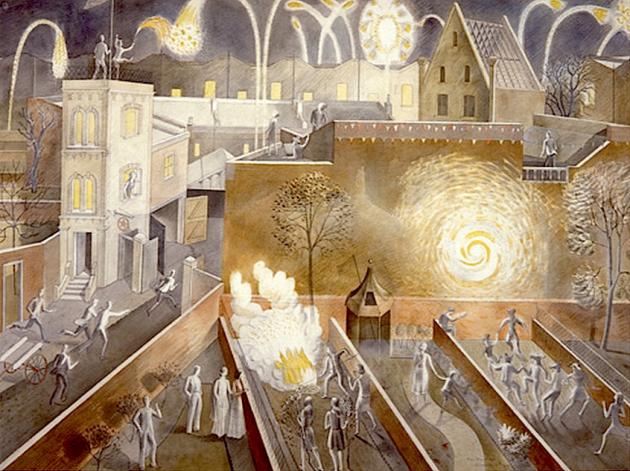It has been over ten years since Eric Ravilious (1903-42) had his first major retrospective at the Imperial War Museum in London. I first discovered his work through his ceramic designs for Wedgwood. My family owned a large punch bowl titled, “The Boat Race” and I was always fascinated by the narrative ability of his linear style. Ravilious’ graphic sensibilities have always been central his practice. Like his teacher at the Royal College of Art, Paul Nash and the Americans Grant Wood and Thomas Hart Benton, he is able to distort perspective in order to fill every corner of the artwork with an elaborate chronicle.
The exhibition reveals a complex and distinctive insight into an artist who died in 1942 in a seaplane crash off Iceland while on duty as an official War Artist. Ravilious worked in a meticulous and laboured style. His muted palette often uses a pea green tone ever so popular in 1930s culture. His subject matter is a composite of Britishness, a kind of Bekonscot world where every day a cricket game happens on the village green and a church fete serves a cream tea. This is a world frozen in the kind of time-warp that Nigel Farage would like to recreate.
Curator James Russell says: “This exhibition has given me the opportunity to look more closely at familiar paintings, and to explore others for the first time. I love Ravilious’s playfulness, and the subtle, surreptitious use of distorted geometries in his paintings, and the fact that he made so little public comment about his own work. In some ways this has made my job more difficult, but at the same time it is liberating: anyone can enjoy the work of Eric Ravilious, but there is also plenty there for people who want to go deeper”
The exhibition adopts a thematic approach separating into sections labelled ‘Relics and Curiosities’: paintings which reveal Ravilious’s fascination with interesting objects such as in No. 29 Bus (1934) and Talbot-Darracq (1934). ‘Interiors’ highlights another thread to Ravilious’s work where neatly made beds, empty chairs and patterned wallpaper and ‘Figures & Forms’ highlights Ravilious’s rare but sensitive portrayal of people, such as in his studies for the mural for Morley College (1928-1930) and in his timeless visual records of men at war.
This is a very good little exhibition and well worth the trek out to Dulwich. If you would like to find out more about the artist they have published a catalogue which perfectly reproduces the illustrative work in the exhibition.
This new show has just opened at the Dulwich Picture Gallery and is on view until 31 August.
PC Robinson © Artlyst 2015 Photo: Courtesy Dulwich Picture Gallery
Watch Video

